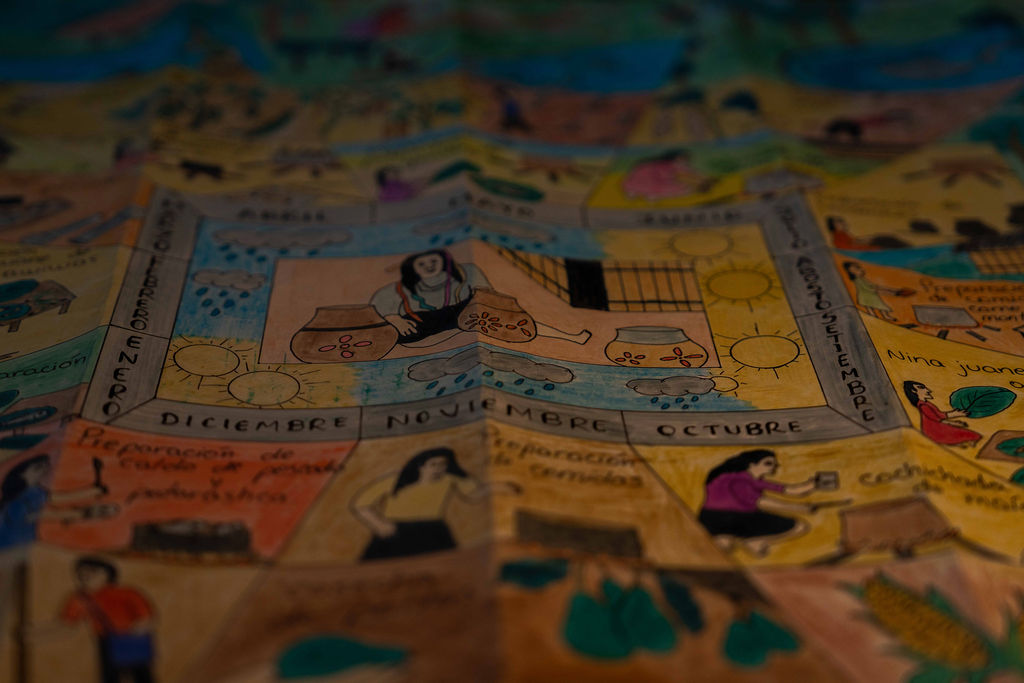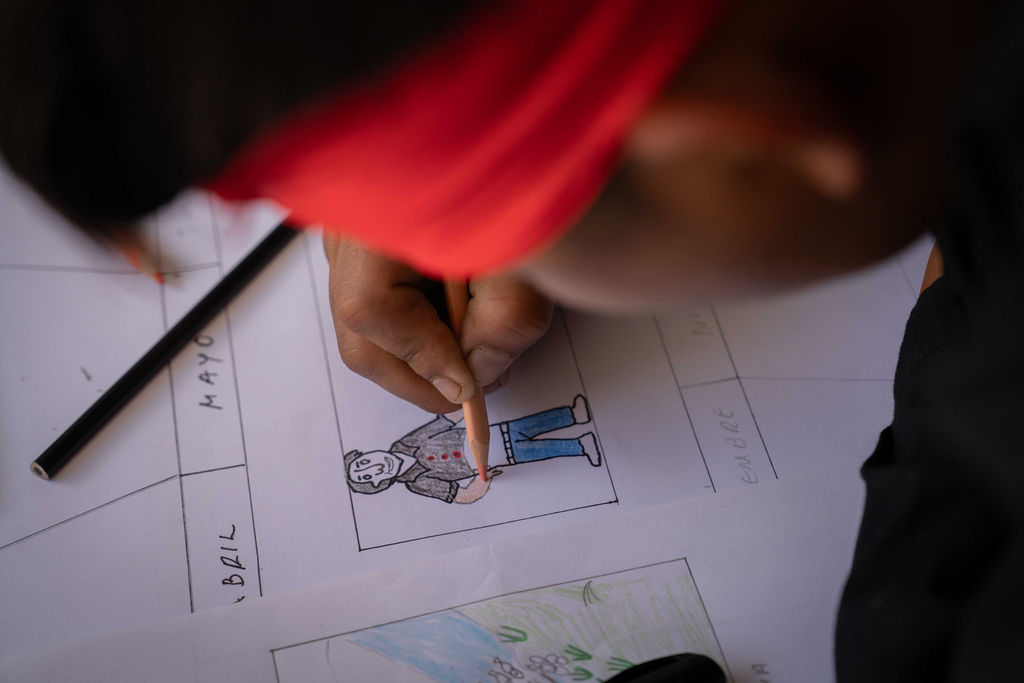



Amazonian Calendars: Indigenous Data Visualizations centers Indigenous ways of knowing within the field of data visualization through a collaboration between MIT and Quechua communities in the so-called Peruvian Amazon. Led by Catherine D’Ignazio and Claudia Tomateo, a Quechua-Chanka PhD student, the project unfolds as a continuation of long-standing relationships with PRATEC and Waman Wasi, nonprofits that have facilitated the creation of community calendars for more than 35 years.
Indigenous visualizations are a significant part of the past and present of data visualization, though they have been largely overlooked by Western historians and practitioners. In the Amazon, Quechua community members create large-scale calendars that visualize ancestral activities, regenerate biocultural diversity, and communicate knowledge. Each calendar uniquely represents Quechua-Amazonian worldviews through artistic depictions of humans, animals, water, and forests that reflect the community’s context and aspirations. These cosmo-visualizations embody intergenerational expressions of worldmaking. Western artists and data visualization practitioners stand to learn a great deal from Indigenous visualizers. Through collaborating with PRATEC and Waman Wasi, the project emphasizes the importance of orality as a foundation for artistic expression and for the transmission of knowledge. Using Indigenous methodologies grounded in the principles of respect, reciprocity, relevance, and responsibility, the exhibition is co-designed with Quechua artists, elders, youth, and community leaders. The process involves ongoing dialogue and collaboration across the three communities of Yaku Shutuna Rumi Alto Huaja, Simbakiwi Yaku Santa Elena, and Maray, where the co-design workshops and film recordings took place.
Each community’s organizational structure forms an integral part of the project. Within PRATEC and Waman Wasis’s network, every community includes an Apu (community leader), Gestor Comunitario (youth leadership), Warmikuna Tarpudoras(intergenerational group of women leading biodiversity initiatives), Presidenta de las Warmikunas, Grupo de Abuelos(grandfathers dedicated to forest care and medicine), and Presidente de Abuelos. The Indigenous visualizers, who are part of the Gestores Comunitarios, facilitate the making of the communal calendar and serve as key collaborators and points of contact throughout the exhibition process.
This exhibition emerges from relationships that have been cultivated over time, rather than as a single event. It represents an ongoing commitment to hold space for Indigenous art and knowledge resurgence within academic and artistic institutions. For the first time at MIT, an exhibition of this scale presents community-created visualizations from the Amazon narrated and explained by community members themselves.
Amazonian Calendars opens within the context of the Information+ 2025 Conference at MIT, a multidisciplinary event on information design co-hosted by the Leventhal Center for Advanced Urbanism. The exhibition invites students, scholars, and visitors to engage with Indigenous approaches to data, design, and worldmaking, catalyzing conversations about what visualization can be when grounded in relationality and reciprocity. The exhibition is made possible with the generous support of the MIT Center for Art, Science & Technology (CAST), the Leventhal Center for Advanced Urbanism (LCAU), and the PKG Center for Public Service.
Catherine D’Ignazio Catherine D’Ignazio is the director of the Data + Feminism Lab and an associate professor of Urban Science and Planning in the Department of Urban Studies and Planning (DUSP) at MIT. She is interested in creative ways to democratize data science, AI, and technology for social justice.
Claudia Tomateo Claudia Tomateo is a PhD student in Urban Planning in the Department of Urban Studies and Planning (DUSP) at MIT. Tomateo is a detribalized Indigenous woman descendant of the Quechua Chanka people. She is an architect, urban designer, activist, and educator studying Indigenous data visualization as a tool for collective liberation and the design of Indigenous futures. Grounded in Indigenous methodologies, she hopes to contribute to the dismantling of hegemonic, patriarchal, and extractive academic structures.
Grimaldo Rengifo Vásquez Community Advisor Grimaldo Rengifo Vásquez (Tocache, San Martín, Peru) is an educator, writer, consultant, and researcher in intercultural education. He co-founded the Proyecto Andino de Tecnologías Campesinas (PRATEC) in Lima in 1988 and later co-founded Waman Wasi in 2002, a nonprofit organization based in Lamas, San Martín, dedicated to cultural affirmation projects in Andean-Amazonian communities. His work has centered on teacher training, supporting farming families, and fostering intercultural dialogue. From 2020 to 2023, he served as a member of Peru’s National Council of Education.
Girvan Tuanama Fasabi Visiting Artist/Indigenous Visualizer Girvan Tuanama Fasabi is a Quechua knowledge keeper and steward of Indigenous ecological wisdom from the Peruvian Amazon. Since 2015 he has served as Coordinator of Community Education with the non-profit Waman Wasi, where he leads the development of biocultural calendars—large-scale visualizations of ancestral activities that act as teaching tools and vehicles for regenerating biocultural diversity. Tuanama was raised in traditions of agrobiodiversity and ecological stewardship, and has trained teams of community facilitators across 22 Andean-Amazonian communities. He will join the exhibition at the Massachusetts Institute of Technology as lead facilitator in the creation of biocultural calendars.
Jasmin Ramirez Jasmin Ramirez is a Quechua filmmaker and photographer from Huancayo, Peru, shaped by the mountains and snow-capped peaks that frame her vision. From the Andes, she learned that every person and every landscape holds a story that needs to be told. With over six years of experience, she works with international organizations to share stories on human rights, sustainability, and environmental conservation. Founder of YLLAFilm, a film and audiovisual production company, guided by the motto: “La realidad la tejemos juntxs.”
Sofía Chiappero Sofía Chiappero is a designer and strategist exploring how design and technology can shape more thoughtful human experiences. Her work bridges physical and digital environments, creating systems, experiences, and tools that help people connect, reflect, and act with intention.
Hai Yi Blue Chan Hai Yi Blue Chan is currently pursuing a Master of Architecture at MIT. Trained in Jewelry and Metalsmithing at the Rhode Island School of Design, she approaches architecture as a form of translation—between material and memory, precision and play. Her practice considers how fragments of the past might be reworked to meet present needs. Outside the studio, she enjoys cooking and collecting stones, small rituals that keep her close to the textures and rhythms of everyday making.